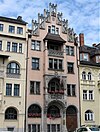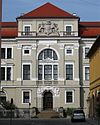Richard-Wagner-Strasse (Munich)
| Richard-Wagner-Strasse | |
|---|---|
| Street in Munich | |
| Richard-Wagner-Str. 5-11 | |
| Basic data | |
| place | Munich |
| Borough | Maxvorstadt |
| Created | 1897 |
| Connecting roads | Brienner Strasse , Gabelsbergerstrasse |
| Buildings | E.ON , State Palaeontological Collection, Paleontological Museum |
| Technical specifications | |
| Street length | 210 m |
The Richard-Wagner-Straße is a street in the Bavarian capital Munich . It is named after the composer Richard Wagner (1813–1883), who lived in the immediate vicinity at Brienner Strasse 37 in 1864/65 .
location
The short street was laid out in 1897 as part of the planned development of the Maxvorstadt and forms part of the large right-angled street area of this district. It leads from Brienner Strasse in a north-easterly direction to Gabelsbergerstrasse . It is bent about halfway up.
history
The houses on the street were built between 1899 and 1906, mostly based on designs by the architect Leonhard Romeis (1854–1904). In the design, he cited different building eras, following the taste of the times of late historicism , in order to create the impression of a grown street. The rich structure of the houses, which is still largely preserved today, creates a particularly picturesque, self-contained area, which is a listed building as an ensemble. The eleven surviving historic houses on this street are also listed as individual monuments. More recent are the Brienner Forum (formerly the head office of the energy company E.ON , now the headquarters of the Munich School of Politics ) as well as a municipal kindergarten (No. 14) and a student residence (No. 16).
The proximity to Königsplatz made the street an address for the upper middle class. The brewery owner Joseph Schülein (1854–1938) lived there until he moved to Gut Kaltenberg (No. 7). His son-in-law, the Jewish surgeon Alfred Haas , ran a private clinic (No. 17 and 19). The editor Fritz Gerlich (1883–1934) lived in house number 21 until his imprisonment and murder.
During the Nazi era, the Nazi horse racing organization Kuratorium for the Brown Ribbon of Germany was housed in house no.7 from 1940 . A so-called Jewish house was set up in house number 11 .
Several institutions have or had their headquarters in the street, such as the former Royal School of Applied Arts , today the State Palaeontological Collection with the Palaeontological Museum (No. 10), and the Isar-Amperwerke or E.ON, today the Munich School of Politics.
buildings
| No. | function | built | description | image |
|---|---|---|---|---|
| 1 | ||||
| 2 | Back of the Lenbachhaus | |||
| 3 | ||||
| 5 | Tenement house | 1900 | five-storey neo-renaissance building with raised projecting stair tower, by Leonhard Romeis |
 more pictures |
| 7th | Residential building | 1901/02 | four-story neo-Gothic building with a stepped ornamental gable, built by Leonhard Romeis for Joseph Schülein |
 more pictures |
| 9 | Tenement house | 1901/02 | three-storey neo-renaissance building with relief decoration and polygonal bay tower, by Leonhard Romeis |
 more pictures |
| 10 | Bavarian State Collection for Paleontology and Geology with the Paleontological Museum , formerly part of the School of Applied Arts | 1899/1902 | representative, three-storey, largely free-standing neo-baroque block with atrium, architectural sculpture and open staircase on the south side, by Leonhard Romeis; construction-time enclosure |
 more pictures |
| 11 | Tenement house | 1900/01 | four-story neo-renaissance building with box oriel and stepped gable, by Leonhard Romeis |
 more pictures |
| 13 | Tenement house | 1905 | four-storey neo-renaissance building with saddle roof, box bay window and three-dimensional decor, by Fritz Seidlmair |
 more pictures |
| 14th | Municipal day care center "Friedrich Schiedel" |
|||
| 15th | Tenement house | 1903/04 | four-storey wide-pitched saddle roof building with gable and historicist-tectonically designed plastered field facade, by August Zeh, restored in a simplified manner after war damage, facade reconstruction in 1997/98 |
 more pictures |
| 16 | Van Calker Foundation student residence | 30 student apartments and 3 married couple apartments | ||
| 17th | Tenement house | 1910/11 | four-storey Art Nouveau building with longitudinal balconies with elaborate metal grids, stretched between three-sided bay windows, by Franz Rank |
 more pictures |
| 18th | Tenement house | 1899/1900 | four-storey, largely free-standing corner building of historicism with tower-like corner formations, by Leonhard Romeis |
 more pictures |
| 19th | Residential building, former private clinic Dr. Haas | 1910/11 | four-storey art nouveau building with rusticated ground floor and above it a longitudinal balcony spanned by two three-sided cores, by Max Neumann, facade simplified |
 more pictures |
| 27 | Tenement house | around 1900 | four-storey historic corner building with a central box bay window and side balconies; Memorial plaque for Fritz Gerlich , who lived in this house |
 more pictures |
literature
- Jutta Ostendorf: The Richard-Wagner-Strasse in Munich . The houses and their stories. Volk, Munich 2007, ISBN 3-937200-37-1 .
- Heinrich Habel, Johannes Hallinger, Timm Weski: State capital Munich . Center. In: Bavarian State Office for Monument Preservation (Hrsg.): Monuments in Bavaria - independent cities and districts . tape I.2 / 1 . Karl M. Lipp Verlag, Munich 2009, ISBN 978-3-87490-586-2 , p. 23, 931-938 .
Web links
Individual evidence
- ^ Richard-Wagner-Strasse at the Bavarian State Office for Monument Preservation
- ↑ Helga Pfoertner: Living with history. Vol. 1, Literareron, Munich 2001, ISBN 3-89675-859-4 , pp. 144–145 ( PDF; 1.1 MB ( Memento from April 28, 2014 in the Internet Archive ))
Coordinates: 48 ° 8 ′ 51.4 ″ N , 11 ° 33 ′ 47.9 ″ E
